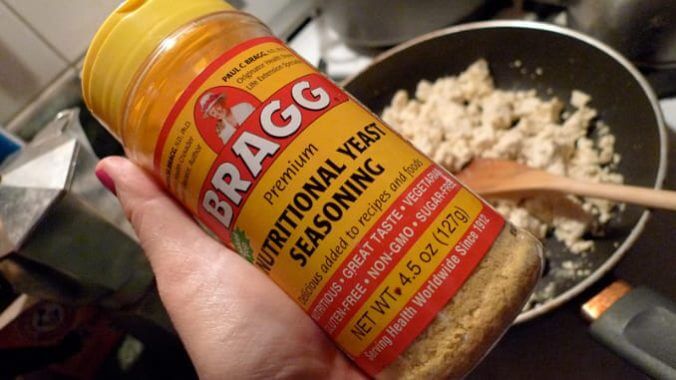Growing up, I wasn’t a huge cheese fan, but I enjoyed it. Like many kids, parmesan on my pasta, pizza and mac and cheese were probably my favorite forms. But I was a picky eater, so I preferred freshly grated parmesan and didn’t care for the powered stuff in the canisters or the pre-shredded varieties. And as far as mac and cheese went, it was Kraft or bust.
Today, my taste is vastly different. I’ve been a vegan since 2014, so I don’t consume any dairy cheese, but I’m not too keen on vegan cheese either. That’s not to say I don’t like it—I think there are several great brands out there, so no bashing from me—but I’m just too busy obsessing over nutritional yeast as my vegan “cheese” of choice.
If you’ve heard of nutritional yeast, have tried it, and like it—yay. If you’ve never heard of it, you might be skeptical. That’s okay because I was too. I had never even heard of nutritional yeast until I made the switch to veganism. But it’s not new on the market. It’s been around for a while, and it’s not just vegans who are eating it.
Shortly after removing animal products from my life, I often watched vlogs and scrolled through Instagram to get ideas of what other people with my same lifestyle and dietary habits were eating. It was so interesting to see the array of plant-based foods that are out there when I actually took the time to look. I went from being called a “picky eater” to feeling like I had stepped into a new world, trying out so many amazing foods I had for some reason never ventured to try before. It wasn’t long before I happened upon nutritional yeast.
When I first heard the name of this food, I was a bit taken aback. I knew that yeast was used to make bread, but I didn’t know anything about a yeast that was edible on its own. While nutritional yeast hit store shelves in the ‘50s, according to NPR, it came to rise in the hippie movement when foods like tofu and granola became mainstream, as messages promoting whole, unprocessed foods and environmental sustainability were spread—hence its popularity among vegans and health enthusiasts.
Sort of a spin-off of baking yeast, nutritional yeast, which looks like little yellow flakes, is made in a similar fashion but are deactivated with heat in the final processing so that it loses its leavening ability. According to the New York Times, this essentially entails culturing yeast for a couple of days, deactivating it with heat and then preparing it to be packaged. It is in the deactivation process that proteins and amino acids, like glutamic acid—which occurs naturally in many fruits and vegetables—give it its cheese-like umami flavor it’s touted for.
The nutritional yeast enthusiasts I encountered always mentioned the cheesy and nutty flavor it had, which made it the perfect replacement for parmesan cheese, specifically. It’s often used to top pizza, pasta, and popcorn. What’s more, some have claimed that it offers a slew of nutritional benefits.
Aptly named, nutritional yeast is packed with nutrients, like B vitamins, fiber, and protein, in its own unfortified form. But, it’s often packaged as a fortified version, with even more nutrients added, making it notably a great source of vitamins B1, B2 (riboflavin), B6 (pyridoxine), potassium and zinc, as well as B12 and B9 (folic acid), according to WebMD. These vitamins and minerals are especially essential in heart health, immune system support, physical recovery and fighting fatigue.
However, some health experts, like nutrition, food studies, and public health professor Marion Nestle, don’t agree that studies fully support the idea that nutritional yeast offers significant health benefits. And yet, she still supports using it as a flavor-enhancing ingredient.
Genuinely health-enhancing or not, once I was bombarded with nutritional yeast content, I knew I had to head to a health food store—where the condiment is often sold—to finally try it, and once I did, I never looked back. It wasn’t outright love at first bite, but I was intrigued enough to grow to really like it, and now, I remain obsessed.
I put nutritional yeast on just about anything. I use it so much, I’ve decided to now stick with an unfortified version so as not to go overboard on nutrients. Using it like grated cheese, I go beyond simply tossing it over popcorn or adding it to Italian dishes. I’ll put it on all sorts of grains, vegetables, fruits and more. You name it, I’ve tried it or would try it with nutritional yeast. It has such a unique profile that offers a perfect amount of versatile cheesiness and umami, adding a layer of texture and flavor pizazz with which no other condiment can compete.
